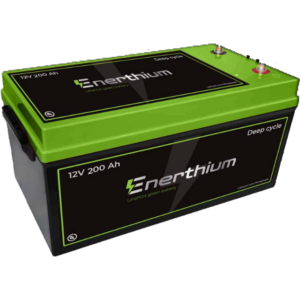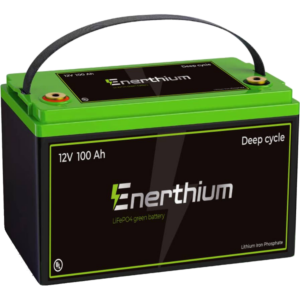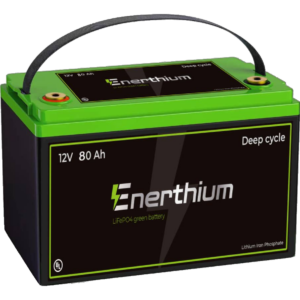This specification provides information regarding the performance of the rechargeable LiFePO4 battery pack EN-12V 300Ah manufactured by Enerthium, Co, Ltd. including the type, technical characteristics, warnings and cautions. The battery pack also incorporates Bluetooth® connectivity to access battery information and status using an Android or IOS mobile Application. The customer should verify that their mobile device and Android software is up to date and compatible with the mobile App.
Self-heating option for Canadian climates.
@ Battery initial Temperature 25 ±5°C
| NO. | Items | Description |
| 1 | Rated Capacity | 300Ah |
| 2 | Minimum Capacity | 300Ah |
| 3 | Energy | 3.84KWh |
| 4 | Nominal Voltage | 12.8V |
| 5 | Outgoing Voltage | ≥12.8V |
| 6 | Internal resistance | ≤15m0 |
| 7 | Series parallel application | Max 4 Series or parallel connections should be performed by qualified personnel only |
| 8 | Limited charge voltage | 14.6±0.2V |
| 9 | Floating charge voltage | 13.8±0.2V |
| 10 | Standard charge current | 60A |
| 11 | Maximum charge current | 200A |
| 12 | Heating temp ranges | -30–0°C |
| 13 | Standard discharge current | 100A |
| 14 | Maximum discharge current | 200A/ @Battery initial Temp 25±5°C |
| 15 | Pulse discharge current | Withstand the 300A/3s |
| 16 | Discharge cut-off voltage | 8.0±0.2V |
| 17 | Dimension | Length: 522±2mm |
| Width: 240±2mm | ||
| Height: 230±2mm | ||
| 18 | Weight | Approx: 30.5±1Kg |
| 19 | Operating Temperature | Charging: 0~45°C |
| Discharging: -20~60°C | ||
| Recommended operating temperature: 15°C~35°C | ||
| 20 | Self-discharge rate | Residual capacity: ≤3%/month; ≤15%/years |
| Reversible capacity: ≤1.5%/month; ≤8%/years | ||
| 21 | Storage Temperature & Humidity Range | Less than 1 month: -20°C~35°C,45% RH~75% RH |
| Less than 3 months: -10°C~35°C,45% RH~75% RH | ||
| Recommended storage environment: 15°C~35°C, 45% RH~75% RH | ||
| Long time storage
If the battery needs to be stored for a long period of time, before storage ensure the battery voltage is at least 13.2V (50% SOC). The battery should be stored as per the conditions and warnings indicated in this specification. The battery should be cycle charged (charge/discharge) at least once every six months. |
||
Standard Test Conditions
| NO. | Items | Criteria | Testing Method | |
| 1 | Internal resistance | ≤15m0 | 50% battery SOC state frequency of 1 KHZ ac resistance tester. | |
| 2 | Cycle life (DOD%100) | ≥6000 cycles | Discharged at a rate of 0.33C until fully dischar- ged, then rested for 1 hour. Charged at a rate of 0.33C and voltage of 14.6V to full capacity, then rested for 1 hour. Process was repeated until full charge capacity was no more than 80% of normal value. Accumulated charge/discharge cycles is defined as Cycle Life. | |
| 3 | Discharge Temperature Characteristics | -20°C | ≥70% | At 25±5°C discharge the battery at a rate of 0.33C to the cut-off voltage and record charge capacity. Store the battery at various temperatu- res for 2h and discharge the battery at 0.33C to the cut-off voltage. |
| 0°C | ≥80% | |||
| 25°C | ≥100% | |||
| 55°C | ≥95% | |||
| 4 | Charge Retention ability | Residual capacity ≥80% | Charge the battery to full capacity and store for 28 days, then discharge at 0.33C to the cut-off voltage. | |
| Recovery capacity ≥90% | ||||
| 5 | Communication Function | Bluetooth | User can read the battery information such as voltage, current, SOC, temperature and other parameters. | |
The batteries are supplied with a LiFePO4 Battery Management System (BMS) that can monitor and optimized each single prismatic cell during charge & discharge, to protect the battery pack from overcharge, over discharge, and short circuit conditions. The BMS helps to ensure safe and accurate operation.
| Items | Content | Specification |
| Over charge | Over-charge protection for each cell | 3.80±0.03V |
| Over-charge release for each cell | 3.60±0.04V | |
| Over-charge release method | Under the release voltage | |
| Over discharge | Over-discharge protection for each cell | 2.3±0.05V |
| Over-discharge release for each cell | 2.8±0.05V | |
| Over-discharge release method | Charge to recovery | |
| Over current | Discharge over current protection | 500A |
| Protection delay time | 0.5s~2s | |
| Over current release method | Delay about 8s after recovery | |
| Short circuit | Do not short-circuit the electrodes | Designed For 600A /500us |
| Battery temperature | Charge over temperature | Protection @65±5°C |
| Release @50±5°C | ||
| Discharge over temperature | Protection @65±5°C | |
| Release @50±5°C | ||
| Charge low temperature protection | Protection @-10±5°C | |
| Release @0±5°C | ||
| MOSFET over temperature protection | Protection @103±10°C | |
| Release @75±10°C |
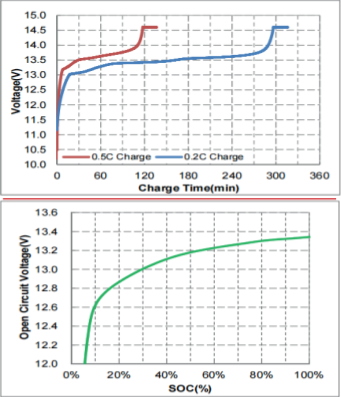
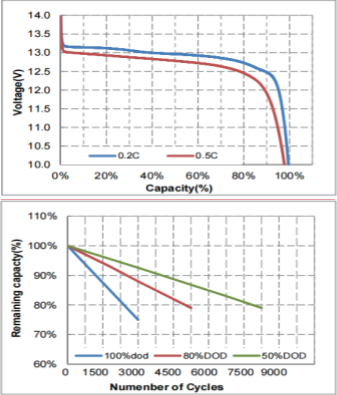

User should read and follow the specifications and cautions indicated on the battery before use. Improper use may cause overheating, fire, rupture, damage or capacity deterioration of the battery. Enerthium powered by EVB360 Inc. will not be held responsible for any accidents caused from abnormal use or without following the battery limits, specifications and warnings.
Charge and discharge
Overcharging the battery for a brief time will not adversely affect the use of the battery. Do not charge for extended periods of time or over discharge as this can affect the function of the battery and cause premature failure or create serious safety hazards, If extended floating time is anticipated, use the recommended floating model specification. If the battery is not in use for an extended period of time, its own self-discharge characteristics shall cause it to discharge. To prevent this occurrence, the battery should be maintained at capacity using a voltage at 50% state of SOC.
Because batteries utilize a chemical reaction, battery performance will deteriorate over time even if stored for a long period without being used. In addition, if the various usage conditions such as charge, discharge, ambient temperature, etc. are not maintained within the specified ranges, the life expectancy of the battery may be shortened or the device in which the battery is used may be damaged by electrolyte leakage. If the discharge time is much shorter than normal after being fully charged per instructions and specifications, it may indicate it is time to change the battery.
